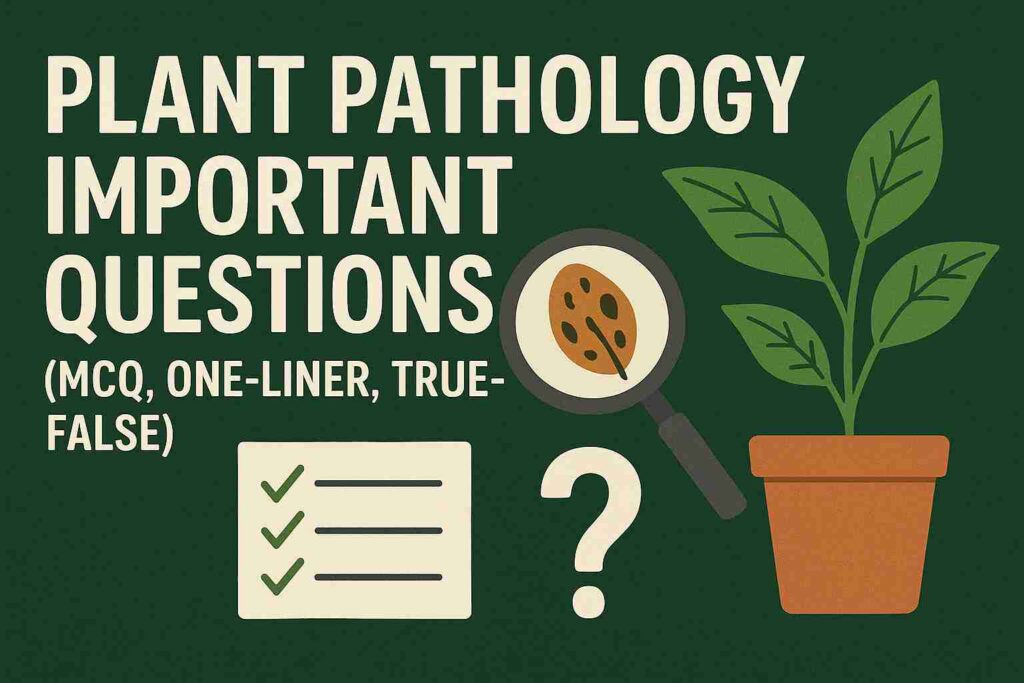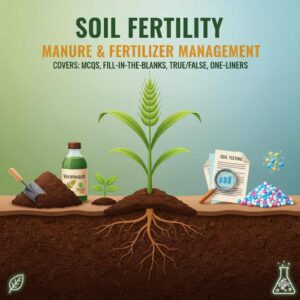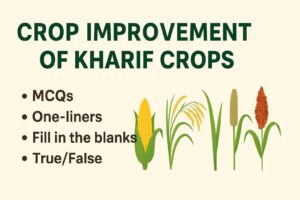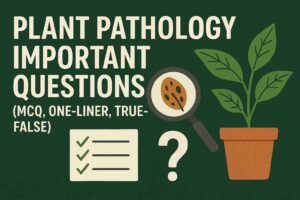
Author–Kumesh choudhari
Preparing for BSc Agriculture Plant Pathology MCQ-based exams is never easy. Most students face the problem that important questions like MCQs, fill-in-the-blanks, true/false, and one-liners are scattered in different books and notes. During exam time, this makes revision stressful and time-consuming.
To solve this problem, I have created this post where you will get all the important Plant Pathology questions in one place. This collection is designed specially for BSc Agriculture students, but it will also be helpful for those preparing for ICAR-JRF, SRF, or other competitive agriculture exams.
Here, I have included questions related to the major diseases of crops like Rice, Maize, Sorghum, Bajra, Groundnut, Soybean, Pigeonpea, Finger millet, Pulses, Castor, Tobacco, Guava, and Banana. The questions are arranged in formats like MCQs, Fill in the blanks, True/False, and One-liners so that you can practice and revise more effectively.
👉 If you are looking for a complete, exam-focused collection of BSc Agriculture Plant Pathology MCQ and related questions, then this post will definitely help you.
Top 40 BSc Agriculture plant pathology MCQ
Part-1
The causal organism of rice blast is:
a) Pyricularia oryzae
b) Xanthomonas oryzae
c) Helminthosporium oryzae
d) Rhizoctonia solani
Answer: a) Pyricularia oryzaeBengal famine of 1942 was mainly associated with:
a) Rice blast
b) Rice brown spot
c) Rice tungro
d) Bacterial blight
Answer: b) Rice brown spotKhaira disease of rice occurs due to deficiency of:
a) Nitrogen
b) Potassium
c) Zinc
d) Iron
Answer: c) ZincSheath blight of rice is caused by:
a) Rhizoctonia solani
b) Pyricularia oryzae
c) Helminthosporium oryzae
d) Sarocladium oryzae
Answer: a) Rhizoctonia solaniFalse smut of rice pathogen is:
a) Sporisorium oryzae
b) Ustilaginoidea virens
c) Claviceps fusiformis
d) Bipolaris oryzae
Answer: b) Ustilaginoidea virensTungro disease of rice is transmitted by:
a) Aphids
b) Leafhoppers
c) Whiteflies
d) Jassids
Answer: b) LeafhoppersBacterial blight of rice is caused by:
a) Xanthomonas oryzae pv. oryzae
b) Pseudomonas fluorescens
c) Agrobacterium tumefaciens
d) Rhizobium spp.
Answer: a) Xanthomonas oryzae pv. oryzaeWhich disease of rice shows “kresek” symptom?
a) Sheath blight
b) Blast
c) Bacterial blight
d) Brown spot
Answer: c) Bacterial blightDowny mildew of maize is caused by:
a) Sclerospora graminicola
b) Peronosclerospora sorghi
c) Puccinia sorghi
d) Fusarium oxysporum
Answer: b) Peronosclerospora sorghiTurcicum leaf spot of maize is caused by:
a) Bipolaris maydis
b) Exserohilum turcicum
c) Cercospora zea-maydis
d) Helminthosporium oryzae
Answer: b) Exserohilum turcicum
Part-2
- Stalk rot of maize is mostly caused by:
a) Fusarium moniliforme
b) Xanthomonas spp.
c) Alternaria alternata
d) Phytophthora infestans
Answer: a) Fusarium moniliforme
Disease “Crazy top” in maize is caused by:
a) Sclerophthora macrospora
b) Ustilago maydis
c) Fusarium oxysporum
d) Peronosclerospora philippinensis
Answer: a) Sclerophthora macrosporaGrain smuts of sorghum are caused by:
a) Ustilago spp.
b) Peronosclerospora spp.
c) Claviceps spp.
d) Pyricularia spp.
Answer: a) Ustilago spp.Loose smut of sorghum replaces:
a) Panicle with smut sori
b) Leaves with pustules
c) Stalks with galls
d) Roots with nodules
Answer: a) Panicle with smut soriAnthracnose of sorghum is caused by:
a) Colletotrichum graminicola
b) Cercospora sorghi
c) Pyricularia oryzae
d) Alternaria alternata
Answer: a) Colletotrichum graminicolaThe grain mold complex in sorghum is severe in:
a) Kharif season
b) Rabi season
c) Winter season
d) Spring season
Answer: a) Kharif seasonPearl millet downy mildew is also known as:
a) Green ear disease
b) Yellow ear disease
c) Smut ear disease
d) White ear disease
Answer: a) Green ear diseaseDowny mildew of bajra is caused by:
a) Peronosclerospora sorghi
b) Sclerospora graminicola
c) Claviceps fusiformis
d) Puccinia substriata
Answer: b) Sclerospora graminicolaErgot of pearl millet produces:
a) Honeydew stage and sclerotia
b) Wilt stage
c) Smut spores only
d) Rust pustules
Answer: a) Honeydew stage and sclerotiaErgot of bajra pathogen is:
a) Claviceps purpurea
b) Claviceps fusiformis
c) Ustilago maydis
d) Pyricularia grisea
Answer: b) Claviceps fusiformis
Part-3
Early leaf spot of groundnut is caused by:
a) Cercospora arachidicola
b) Cercospora personata
c) Colletotrichum capsici
d) Alternaria alternata
Answer: a) Cercospora arachidicolaLate leaf spot of groundnut is caused by:
a) Cercospora personata
b) Cercospora arachidicola
c) Colletotrichum gloeosporioides
d) Exserohilum turcicum
Answer: a) Cercospora personataStem and pod rot of groundnut is caused by:
a) Sclerotium rolfsii
b) Rhizoctonia bataticola
c) Fusarium oxysporum
d) Macrophomina phaseolina
Answer: a) Sclerotium rolfsiiWilt of groundnut is caused by:
a) Fusarium oxysporum f.sp. arachidis
b) Pythium debarianum
c) Claviceps fusiformis
d) Colletotrichum falcatum
Answer: a) Fusarium oxysporum f.sp. arachidisGroundnut rosette disease is caused by:
a) Virus (transmitted by aphids)
b) Bacteria
c) Mycoplasma
d) Fungus
Answer: a) Virus (Aphis craccivora vector)Rhizoctonia aerial blight of soybean is caused by:
a) Rhizoctonia solani
b) Fusarium oxysporum
c) Pythium aphanidermatum
d) Sclerotium rolfsii
Answer: a) Rhizoctonia solaniSoybean bacterial spot is caused by:
a) Xanthomonas campestris pv. glycines
b) Xanthomonas oryzae
c) Pseudomonas syringae
d) Agrobacterium spp.
Answer: a) Xanthomonas campestris pv. glycinesSoybean seed and seedling rot is caused mainly by:
a) Phytophthora spp.
b) Fusarium spp.
c) Rhizoctonia solani
d) Colletotrichum spp.
Answer: a) Phytophthora spp.Soybean mosaic is caused by:
a) Potyvirus
b) Orthomyxovirus
c) Caulimovirus
d) Tobamovirus
Answer: a) PotyvirusPhytophthora blight in pigeonpea is caused by:
a) Phytophthora drechsleri f.sp. cajani
b) Phytophthora infestans
c) Phytophthora capsici
d) Phytophthora nicotianae
Answer: a) Phytophthora drechsleri f.sp. cajani
Top 20 BSc Agriculture Plant Pathology fill-in-the-blanks Question Bank
Part-1
The causal organism of sheath rot of rice is ________.
Answer: Sarocladium oryzaeThe pathogen of bacterial blight of rice enters mainly through ________.
Answer: Hydathodes or woundsThe infection cushions or appressoria are characteristic of ________ disease of rice.
Answer: Blast (Pyricularia oryzae)In false smut of rice, grains are converted into ________.
Answer: Greenish-yellow velvety ballsResistance to tungro virus in rice is governed by ________ genes.
Answer: Oligogenic/Polygenic inheritance (mostly polygenic)In maize, common smut is caused by ________.
Answer: Ustilago maydisPolysora rust of maize is caused by ________.
Answer: Puccinia polysoraThe “top shoot becoming leafy” is a typical symptom of ________ in maize.
Answer: Crazy top diseaseErgot disease in sorghum and pearl millet produces toxin called ________.
Answer: Ergot alkaloidsThe initial stage of ergot in pearl millet is known as ________ stage.
Answer: Honeydew stage
Part-2
Grain mold pathogens in sorghum are mostly ________ type fungi.
Answer: Storage or field fungi (Alternaria, Curvularia, Fusarium, Aspergillus)Wilt of pigeonpea shows typical symptom of vascular ________.
Answer: DiscolorationSterility mosaic of pigeonpea is also called as “________ disease of pigeonpea”.
Answer: Green plagueRhizoctonia aerial blight of soybean is most severe under conditions of high ________.
Answer: HumiditySoybean seed and seedling rot disease is favored by ________ soils.
Answer: Waterlogged/poorly drained soilsEarly leaf spot of groundnut produces lesions surrounded by ________ halo.
Answer: YellowLate leaf spot of groundnut produces lesions surrounded by ________ halo.
Answer: Dark or blackCercospora leaf spot disease of black gram appears first on ________.
Answer: Lower leavesYellow mosaic virus of green gram is transmitted by the insect vector ________.
Answer: Whitefly (Bemisia tabaci)Finger millet blast disease affects neck, leaf, and ________.
Answer: Ear/head (panicle)
Top 20 BSc Agriculture plant pathology True/False Questions
Part-1
Bacterial blight of rice is also known as kresek disease in severe stage.
Answer: TrueRice tungro disease is caused by a fungus.
Answer: False (It is viral)Sheath rot of rice is caused by Sarocladium oryzae.
Answer: TrueBrown spot disease of rice is favored by nutrient deficiency and poor soils.
Answer: TrueCommon rust of maize is caused by Puccinia polysora.
Answer: TrueCrazy top disease of maize is caused by a virus.
Answer: False (Caused by Sclerophthora macrospora)Stalk rot in maize is mainly caused by Fusarium moniliforme.
Answer: TrueSorghum anthracnose is caused by Colletotrichum graminicola.
Answer: TrueGreen ear symptom in bajra is the diagnostic feature of downy mildew.
Answer: TrueHoneydew secretion is seen in ergot disease of pearl millet.
Answer: True
Part-2
Ergot of sorghum and bajra is dangerous due to production of antibiotics.
Answer: False (Due to toxic alkaloids)Groundnut collar rot is caused by Sclerotium rolfsii.
Answer: TrueSoybean mosaic produces mottling on seeds and leaves.
Answer: TruePhytophthora blight of pigeonpea occurs in dry soils.
Answer: False (Favored by waterlogged soils)Wilt of pigeonpea is mainly caused by Fusarium udum.
Answer: TrueSterility mosaic of pigeonpea is transmitted by whitefly.
Answer: False (Transmitted by eriophyid mite Aceria cajani)Cercospora leaf spot of black gram produces angular red lesions.
Answer: False (Brown spots with grey centers)Yellow Mosaic Virus (YMV) in pulses is transmitted by Bemisia tabaci.
Answer: TrueWeb blight of urdbean and mungbean is favored by high humidity.
Answer: TrueSigatoka disease of banana is a viral disease.
Answer: False (It is fungal, Mycosphaerella spp.)
Top 20 BSc Agriculture plant pathology One Liner Questions
Which rice disease is characterized by neck blast leading to breaking of panicles?
Answer: Rice blast (Pyricularia oryzae).Which disease of rice shows “leaf blight → kresek stage → wilting”?
Answer: Bacterial blight.Sheath blight of rice produces typical symptom known as?
Answer: Lesions on leaf sheath resembling snake-skin pattern.Khaira disease of rice was first observed in which Indian state?
Answer: U.P. (Tarai region).False smut disease of rice is also called as?
Answer: Lakshmi disease (symbol of prosperity).Brown spot disease of rice is also popularly known as?
Answer: Poor man’s disease.Common rust of maize produces which type of pustules?
Answer: Orange-brown uredospore pustules.Systemic downy mildew in maize gives leaves a typical symptom of?
Answer: Chlorotic stripes.In maize, head smut pathogen replaces?
Answer: Entire ear and tassel with smut sorus.Anthracnose of sorghum causes both leaf spots and ________ rots.
Answer: Stem rots.In sorghum grain mold, grains appear ________ in color.
Answer: Discolored/blackened with fungal growth.Green ear symptom in bajra is diagnostic of which disease?
Answer: Downy mildew (Sclerospora graminicola).Ergot disease of pearl millet is dangerous due to production of?
Answer: Toxic alkaloids causing livestock poisoning.In groundnut, Sclerotium rolfsii forms characteristic structures called?
Answer: Mustard-sized sclerotia.Soybean mosaic virus affects seeds producing which type of seeds?
Answer: Mottled seeds.In pigeonpea wilt, infected plants show internal vascular strands of which color?
Answer: Dark brown to black.Sterility mosaic of pigeonpea is unique because affected plants produce?
Answer: Only vegetative growth, no flowers.Web blight disease of green gram is prevalent under which conditions?
Answer: Warm and humid weather.In black gram Cercospora leaf spot, lesions show which kind of appearance?
Answer: Brown spots with grey centers.Neck blast in finger millet causes failure of what?
Answer: Grain formation in ear heads.
Top 20 Terminology for Plant Pathology (Field & Horticultural Crops)
Symptom:
Visible external expression of a disease in a plant.
Example: Yellowing in khaira disease of rice.Sign:
Actual visible part of pathogen present on host.
Example: White fungal mycelium or spore masses on infected tissue.Inoculum:
Any part of the pathogen that initiates infection.
Example: Spores of Pyricularia oryzae in rice blast.Primary Inoculum:
Pathogen structure that survives between seasons and causes first infection.
Example: Sclerotia of Rhizoctonia solani.Secondary Inoculum:
Pathogen units formed during same crop season, responsible for spreading disease.
Example: Conidia of Helminthosporium in brown spot of rice.Inoculation:
Process of coming in contact between inoculum and host plant.
Example: Deposition of conidia on rice leaf surface.Infection:
Establishment of pathogen inside host after successful inoculation.
Example: Entry of blast fungus through cuticle or epidermis.Incubation period:
Time taken between infection and appearance of first symptom.Latent infection:
Pathogen present but symptoms are not visible initially.
Example: Viruses in some latent period.Pathogen:
A living organism capable of causing disease in host plant.Host:
A living plant that allows survival and multiplication of the pathogen.Pathogenicity:
Ability of a pathogen to cause disease.Virulence:
Degree of pathogenicity of a pathogen.
Example: Some strains of Xanthomonas oryzae more virulent than others.Resistance:
Inherent ability of host plant to restrict pathogen infection.
Example: Resistant varieties of rice against bacterial blight.Susceptibility:
Lack of resistance in host plant, allowing disease to occur easily.Disease cycle:
Sequence of events in the development of a disease from inoculation to final inoculum.Epidemiology:
Study of factors influencing the outbreak and spread of plant diseases.Epiphytotic:
Sudden outbreak of disease in a large area causing heavy losses.
Example: Bengal famine due to brown spot of rice.Obligate parasite (Biotroph):
Pathogen that can survive only on living host.
Example: Rusts and powdery mildews.Facultative parasite (Necrotroph):
Normally saprophytic but can live as a parasite under favourable conditions.
Example: Fusarium, Alternaria.
Get more MCQs and PYQs
Download BSc agriculture All Subject Notes PDFs
BSc Ag. Semseter Name | English Notes PDFs |
1st semester | |
2nd semester | |
3rd semester | |
4th semester | |
5th semester | |
6th semester |
Read Latest post
100+ Manure, Fertilizer, and Soil Fertility Management MCQ with important one-liners, true/false & fill-in-the-blanks
Author–Kumesh choudhari Table of Contents Hey Agri-dost! Exam season is...
Read MoreBSc Agriculture Crop Improvement of Kharif Crops MCQ, one-liner, true/false & fill in the blanks questions for exams
Author–Kumesh choudhari For every agriculture student, understanding the BSc Agriculture...
Read MoreBSc Agriculture Plant Pathology MCQ, one-liner, true/false & fill in the blanks questions for exams
Author–Kumesh choudhari Preparing for BSc Agriculture Plant Pathology MCQ-based exams is never...
Read Morehow to collect soil sample for soil testing
Introduction of how to collect a soil sample for...
Read More



